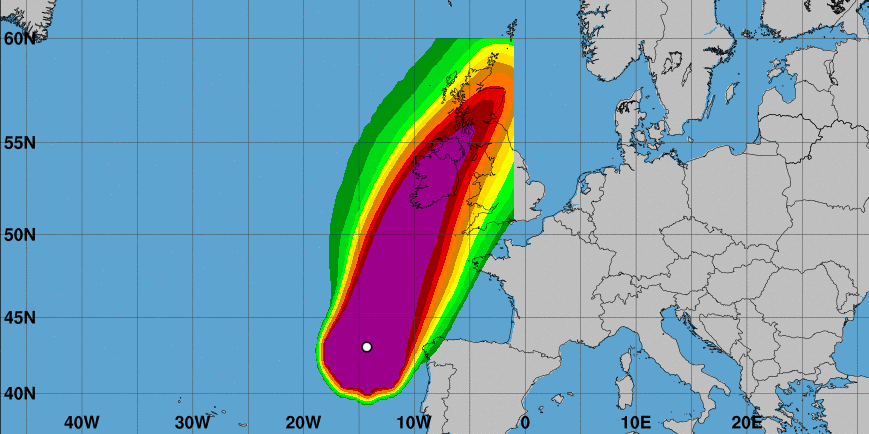Even Meteorologists Think Hurricane Ophelia Is Really Weird

Credit to Author: Caroline Haskins| Date: Mon, 16 Oct 2017 19:25:47 +0000
Post-tropical storm Ophelia is currently ravaging Ireland, and has already killed three people. Ophelia isn’t just unusual for this year, it’s unusual for this century. It’s been more than 50 years since a storm of Ophelia’s magnitude has hit Ireland with Hurricane Debbie, in 1961.
Whenever storms are as powerful and unusual as Ophelia, hurricane forecasts are crucially important.
The US government’s National Hurricane Center’s (NHC) “Atlantic Ops” tweeted a forecast image of Ophelia, showing the chances for various wind speeds over a five-day period. The most recent forecasts say wind speeds could top at 110 miles per hour.
But on Sunday at 5AM, the NHC forecast jarringly severed at 60°North and 0° longitude. This made it unclear what Ophelia does after it passes England and approaches Norway.
While a tweet six hours later provided an expanded update of the forecast, this cutoff occurred because the NHC says it doesn’t normally see storms that far north in the Atlantic.
“Ophelia was an extremely unusual tropical cyclone in terms of how far east and north it was, and so the [forecast] was being cut off,” Mark DeMaria, the acting deputy director of the NHC, told me in an email. “Once we noticed the problem, we made a change that allowed the [forecast] to extend further eastward and northward.”
Ireland’s national meteorological service, Met Éireann, has been providing regular Ophelia forecasts, but the organization sometimes relies on data from the NHC to distribute to its audience.
Michael Brennan, a senior hurricane specialist at the NHC, told me in an email that forecasts are created in two steps: First, a NHC computer system creates a basic forecast. Then a National Weather Service (NWS) supercomputer uses more data to create a final forecast.
However, the NWS supercomputer used decade-old hurricane trend predictions, which didn’t assume a hurricane in 2017 would brew as far northeast as Ophelia.
“The cutoff in the first tweet is due to the boundaries of the [supercomputer] grid,” Brennan said. “Given Ophelia’s unusual location, the graphics that use the [supercomputer] weren’t able to show probabilities along the entire track.”
While the NHC’s hurricane forecasts haven’t been structured with storms like Ophelia in mind, this isn’t necessarily concerning. The NHC primarily focuses on hurricanes that could threaten the United States, but it’s still worth mentioning the overall rarity of a storm like Ophelia.
Jeff Masters, the director of meteorology of Weather Underground, said that none of this means that the Ophelia forecasts were inaccurate—creating them was just challenging.
“The computer models will make reliable forecasts regardless of where a storm is located,” Masters said. “The forecasts made over the past twenty-four hours have been more difficult than usual, due to the fact that the storm was in a region where we had few observations.”
Get six of our favorite Motherboard stories every day by signing up for our newsletter .